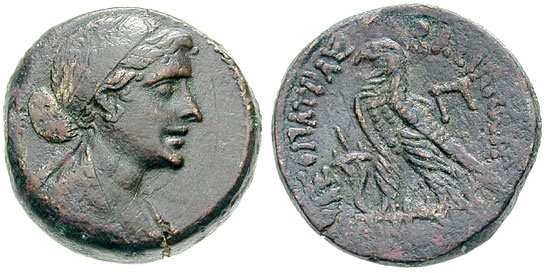Cleopatra: A Serpent of Nile or Goddess Reincarnated?
It is quite unlikely for netizens today to be unaware of the scandalous Queen Cleopatra VII. What we know of her today is perhaps only a fragment of her life, but her legend has incited the imaginations of many. From a shrewd seductress to a divine reincarnation, speculations surround her identity in modern culture. Who was she really? What did she look like? Was she really a seductress? It is time we take a dive.

In most of the coins from her period of reign, historians have observed a sharp, aquiline nose, hinting directly at her Grecian lineage. Her nose seemed to be the focal point of her beauty. Image source: The Blue and White
Cleopatra, a name that is associated with power, royalty, and sensuality in the modern world, was also vilified when its owner was still alive. Cleopatra the Seventh, the last known queen of Egypt, always seemed to be a scandalous figure during her days, at least when examined through hindsight, but it cannot be denied that she served as an excellent queen to her people and remains a famous force to be reckoned with even after the passing of several centuries.
The daughter of Ptolemy XII Auletes and Cleopatra V Tryphaena, Cleopatra VII Thea Philopator was the last known ruler of the Ptolemy dynasty. Born and brought up in Alexandria, Egypt, she spent the majority of her life there before commencing her frequent stays in Rome, the homeland of her contemporaries like Julius Caesar, Mark Antony, and Octavius Caesar, with all of whom her life is significantly intertwined. She may perhaps be known as the ‘Serpent Seductress of the Nile’ to many, but in her golden years, she advanced the kingdom of Egypt to lengths her ancestors didn’t dare dream of. While her name may directly translate as ‘glory of the father’, her deeds exceeded theirs by several folds. Her rule may have lasted for only twenty-one years, but the impact of her rule has led to the publication of hundreds of historical, political, and fictional books in today’s world.
With the little available evidence, historians have emphasised the lack of accurate information to piece together her biography, but the more detailed accounts modern readers seem to depend on are the works of Greco-Roman scholars, particularly Plutarch. Through estimation, she is said to have been born around 70 or 69 BCE. The Ptolemy clan had served as a prominent force in Alexander the Great’s conquest of Egypt around 332 BCE. Following this, they were the sole power ruling the land for a long time. Cleopatra was only eighteen when her father died, and she and her brother, Ptolemy XIII, created a co-regency to rule over Egypt. It has been observed that for most of her reign, Cleopatra was part of a co-regency, first ruling with her father and then with her two brothers.
Cleopatra’s climb to fame did not come without challenges. Soon after her ascension to the throne, hostility grew between her and Ptolemy XIII, leading to a full-fledged civil war that ended with Ptolemy fleeing and supposedly drowning in the Nile. Through this chaos, Cleopatra managed to gather mercenary forces from Syria, garner support from Julius Caesar, and get him to restore her to the throne along with her younger brother, Ptolemy XIV. Her involvement with Caesar, which was especially heightened between 46 and 45 BCE, opened her doors to Rome, allowing her to collect more supporters and resources. She also gave birth to a son named Ptolemy Caesar, who is believed to be Caesar’s son.
Cleopatra’s involvement with Mark Antony is also significant since it not only marks the beginning of her downfall but also the collapse of the entire Egyptian empire. This affair with Mark Antony infamously drove a wedge between the two empires of Rome and Egypt. However, the paramours have been severely romanticised by several writers, like Shakespeare and John Dryden, throughout history. In reality, Mark Antony’s support was essential for Cleopatra to remove her sister and competitor, Arsinoe, from the picture so that her position on the throne could be secured. However, it cannot be denied that her affair with Antony was also openly romantic and heavily challenged the norms set for women in this era. It was this very relationship that led to Octavian Caesar pulling out his support for Egypt and waging a war against them. Cleopatra is also said to have given birth to his twins after he departed for Rome.
A large part of Cleopatra’s regency was dependent on her image and idolization. She is famously associated with the Egyptian goddess Isis, so much so that she was even given the title of ‘New Isis’. This association with divinity may have allowed people to picture her as a divinely beautiful being devoid of flaws. While she is acknowledged by Plutarch to have ‘irresistible charm’, there have been many artefacts that provide a rough picture of what she looked like, which goes on to show us that her features were not extraordinary but her power of persuasion was. Unlike the popular books and movies that propagate her appearance, race, and behaviour without much credit, she is recorded to be a woman with almond-shaped eyes and curls framing her front face while the rest are braided into ringlets and tied into a bun at the back. Her lips are described as soft and full, while her nose is known to be her focal feature. In most of the coins from this period, historians have observed a sharp, aquiline nose, hinting directly at her Grecian lineage.
Often, Cleopatra’s achievement as one of the greatest thinkers of her period is downplayed due to her overtly sexualized reputation. Unlike her portrayal in popular media, she is described as intelligent — she spoke eight languages, including ancient Egyptian, and could also read hieroglyphs. She was also educated in Alexandria by the great preachers of the Hellenistic world. She was affluent in geography, history, medicine, astronomy, diplomatic relations, mathematics, and economics. She is also said to have taken a keen interest in chemistry and cosmetic development. Most of her writings were famously sought after but were lost due to natural hazards.
What many people fail to notice is that Cleopatra’s political alliances were not one-sided; her allies needed the vast wealth of Egypt as much as she needed Roman support to hold her throne. Moreover, her reign allowed the Romans to access the Nile, through which most of their trade was carried out. Her alliance with Rome was also due to the rampant conquests of the Roman Empire during that period. It would have put the people of Egypt under threat if relations were spoiled. To ensure the safety of her people, Cleopatra is said to have built strong relationships with several influential Roman figures, including Octavian Caesar, who led the final campaign against Egypt.
During her reign, the Egyptian economy greatly flourished, and while she may not have any sort of relationship with the likes of Nefertiti and Tutankhamun, she stands on equal footing with them when it comes to popularity. Her claim to the throne was strongly built on the basis of her political performance; patriotism for her nation drove her to put her life on the line to better the nation and guarantee its safety. Despite her contributions, her death is shrouded in mystery and sorrow. There have been several speculations about the cause of her death; some believe she died of a self-induced, poisonous asp bite, while others say she drank a vial of poison from her ring, leading to her death at the young age of thirty-nine. Nevertheless, she lived to witness the downfall and annexation of Egypt at the hands of Octavian Caesar, as well as the death of her lover, Mark Antony, with whom she was buried in a tragically romantic manner.
In modern popular culture, Cleopatra has been portrayed by several exceptionally beautiful and talented actors, including Theda Bara (Cleopatra, 1917), Elizabeth Taylor (Cleopatra, 1963), Vivian Leigh (Caesar and Cleopatra, 1945), Lyndsey Marshal (Rome, 2005-07), and most recently, Adele James (Queen Cleopatra, 2023). The mystery surrounding Cleopatra’s death, however, permeates into her physical remains — her tomb, which still remains unfound 2000 years after her death. It is believed that she had declared that only a woman would be able to find her tomb, and Kathleen Martinez, a famous archaeologist and diplomat, seemed to have undertaken the task, but no such excavations have been made to this day. In her life, her death, and in history, through her beauty and intellect, Cleopatra still remains a relevant and scandalous topic of discussion, even to this day.

‘Cleopatra’s affair with Antony was romantic and heavily challenged the norms set for women in this era’. Source: Shakespearecenter.org


